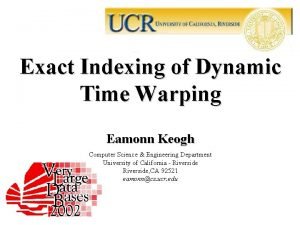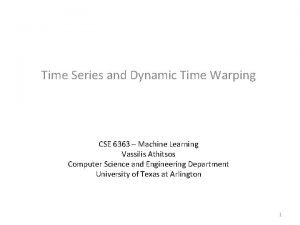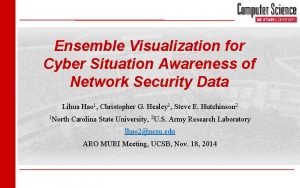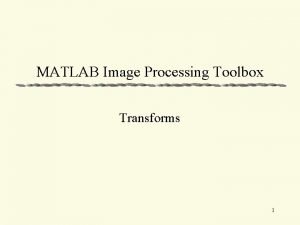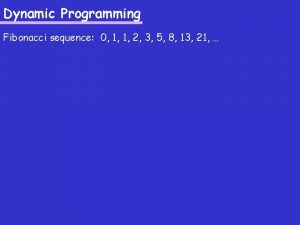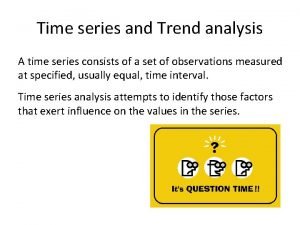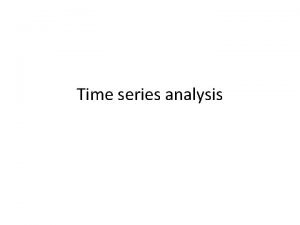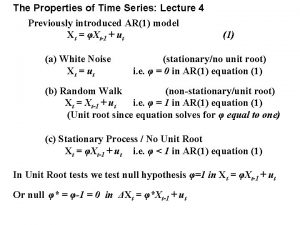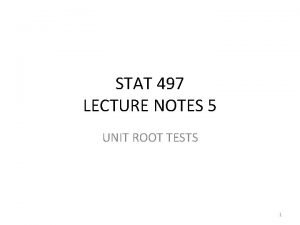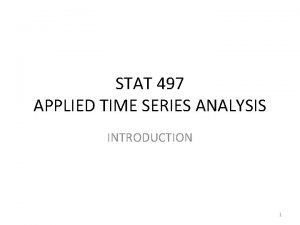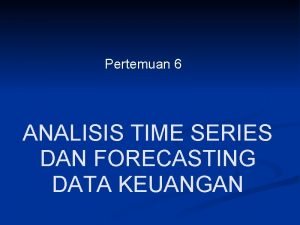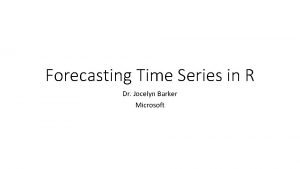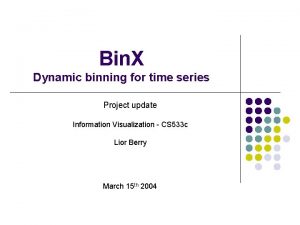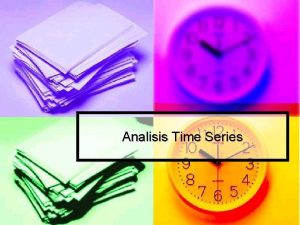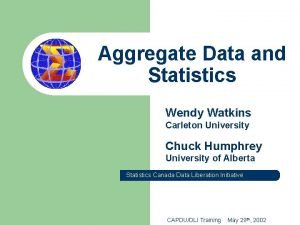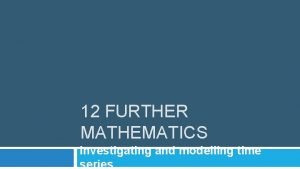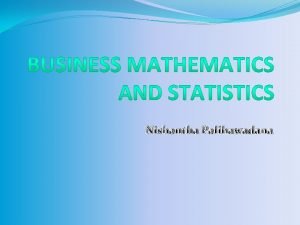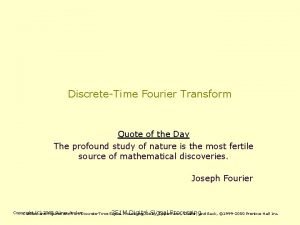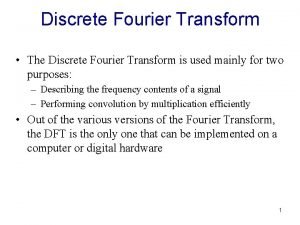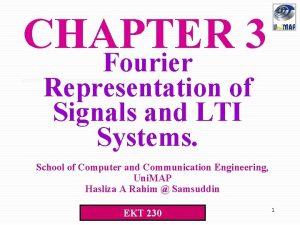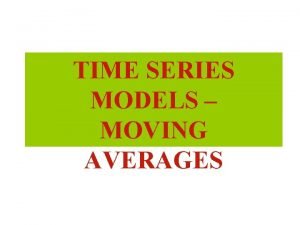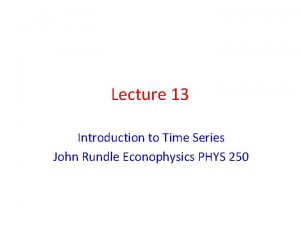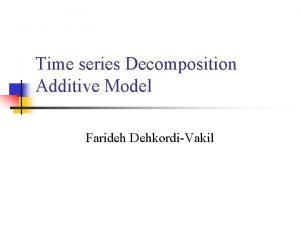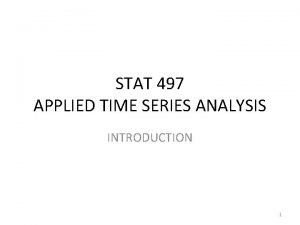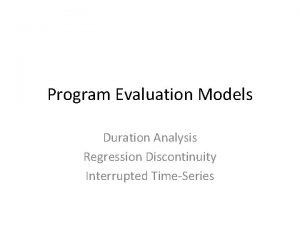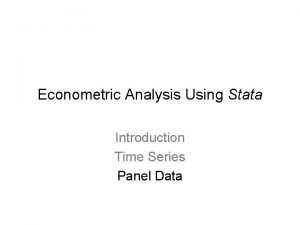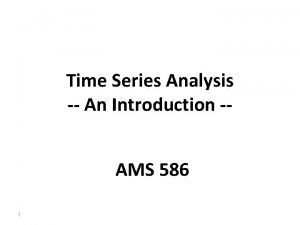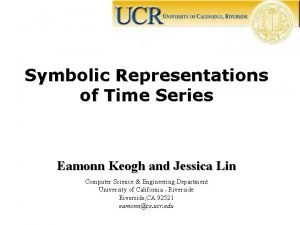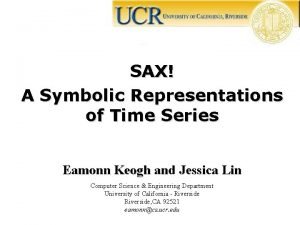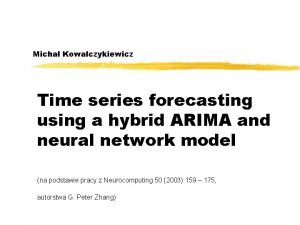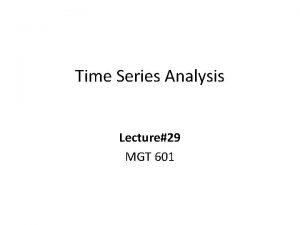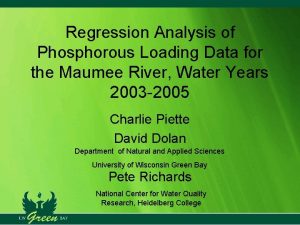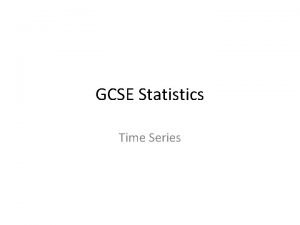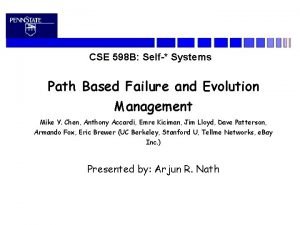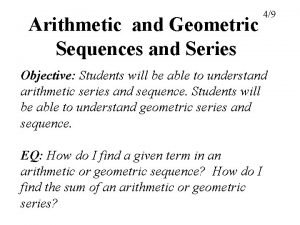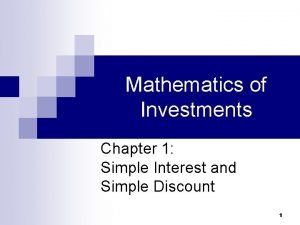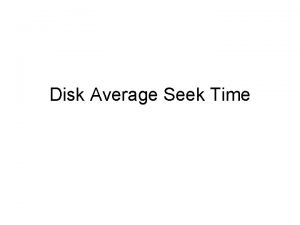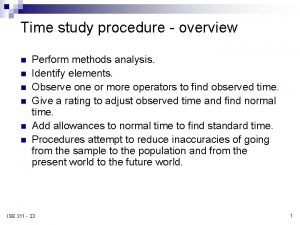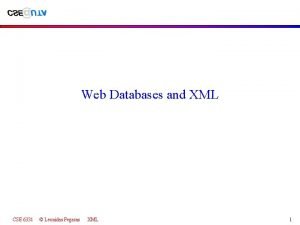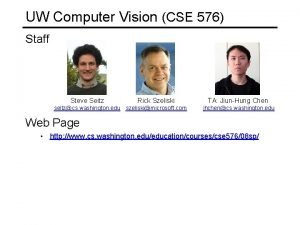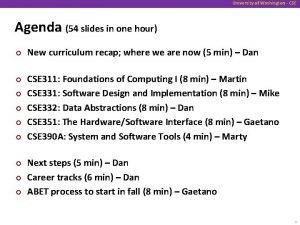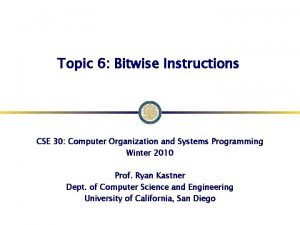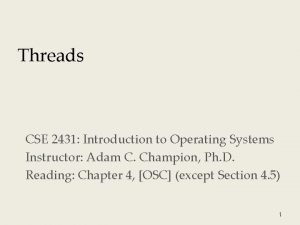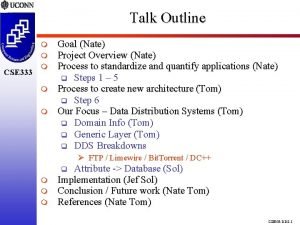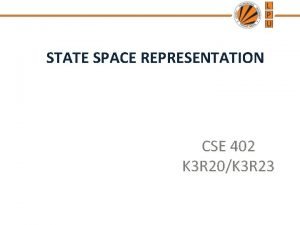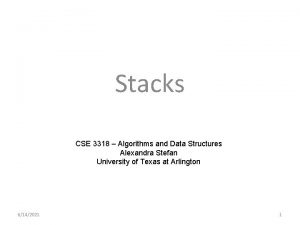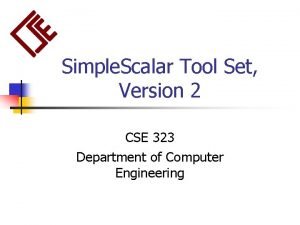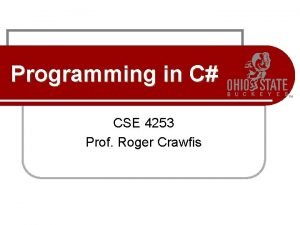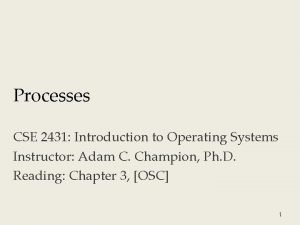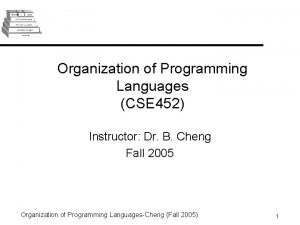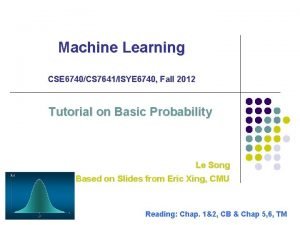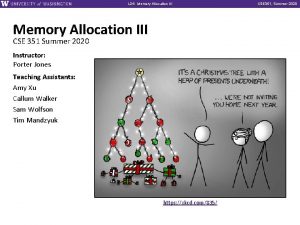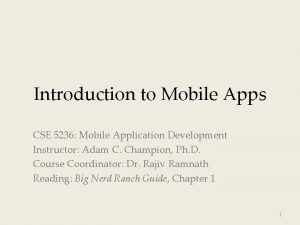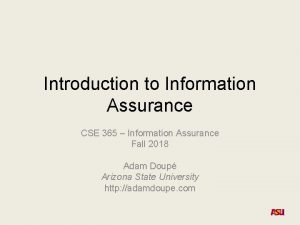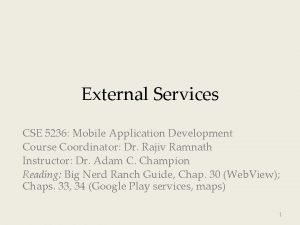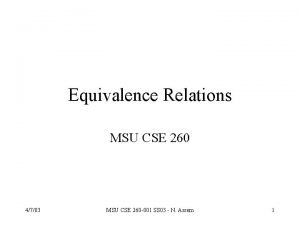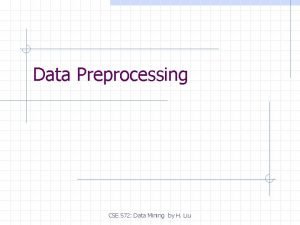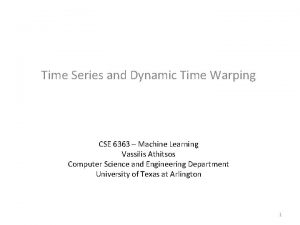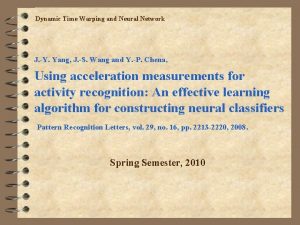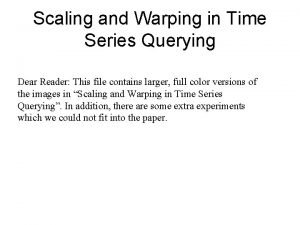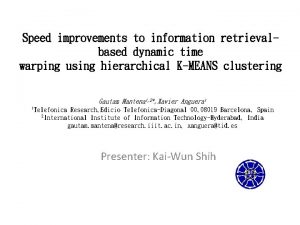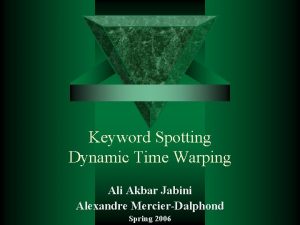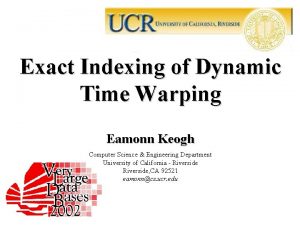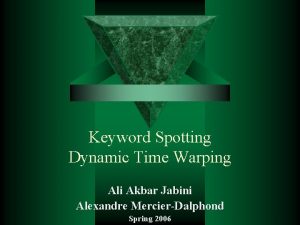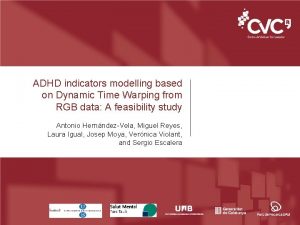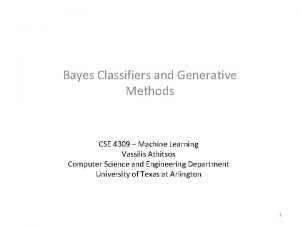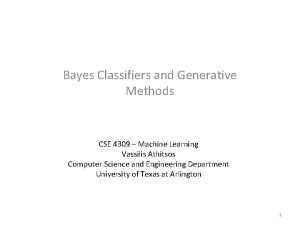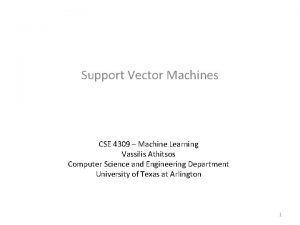Time Series and Dynamic Time Warping CSE 4309
































































































- Slides: 96

Time Series and Dynamic Time Warping CSE 4309 – Machine Learning Vassilis Athitsos Computer Science and Engineering Department University of Texas at Arlington 1

Sequential Data • 2

Time Series • A time series is a sequence of observations made over time. • Examples: – Stock market prices (for a single stock, or for multiple stocks). – Heart rate of a patient over time. – Position of one or multiple people/cars/airplanes over time. – Speech: represented as a sequence of audio measurements at discrete time steps. – A musical melody: represented as a sequence of pairs (note, duration). 3

Applications of Time Series Classification • Predicting future prices (stock market, oil, currencies…). • Heart rate of a patient over time: – Is it indicative of a healthy heart, or of some disease? • Position of one or multiple people/cars/airplanes over time. – Predict congestion along a route suggested by the GPS. • Speech recognition. • Music recognition. – Sing a tune to your phone, have it recognize the song. – Recognize the genre of a song based on how it sounds. 4

Time Series Example: Signs • 0. 5 to 2 million users of American Sign Language (ASL) in the US. • Different regions in the world use different sign languages. – For example, British Sign Language (BSL) is different than American Sign Language. • These languages have vocabularies of thousands of signs. • We will use sign recognition as our example application, as we introduce methods for time series classification. 5

Example: The ASL Sign for "again" 6

Example: The ASL Sign for "bicycle" 7

Representing Signs as Time Series • 8

Feature Vectors • Finding good feature vectors for signs is an active research problem in computer vision. 9

Feature Vectors • We choose a simple approach: the feature vector at each frame is the (x, y) pixel location of the right hand at that frame. 10

Feature Vectors • We choose a simple approach: the feature vector at each frame is the (x, y) pixel location of the right hand at that frame. 11

Feature Vectors • We choose a simple approach: the feature vector at each frame is the (x, y) pixel location of the right hand at that frame. 12

Time Series for a Sign • Using the previous representation, for sign "AGAIN" we end up with this time series: ((192, 205), (190, 201), (190, 194), (191, 188), (194, 182), (205, 183), (211, 178), (217, 171), (225, 168), (232, 167), (233, 167), (238, 168), (241, 169), (243, 176), (254, 177), (256, 179), (258, 186), (269, 194), (271, 202), (274, 206), (276, 207), (277, 208)). • It is a sequence of 22 2 D vectors. 13

Time Series for a Sign • Using the previous representation, for sign "AGAIN" we end up with this time series: ((192, 205), (190, 201), (190, 194), (191, 188), (194, 182), (205, 183), (211, 178), (217, 171), (225, 168), (232, 167), (233, 167), (238, 168), (241, 169), (243, 176), (254, 177), (256, 179), (258, 186), (269, 194), (271, 202), (274, 206), (276, 207), (277, 208)) • It is a sequence of 22 2 D vectors. 14

Time Series Classification Training sign for "AGAIN". 15

Time Series Classification Training sign for "BICYCLE". 16

Time Series Classification Suppose our training set only contains those two signs: "AGAIN" and "BICYCLE". We get this test sign. Does it mean "AGAIN", or "BICYCLE"? 17

Time Series Classification Does this test sign mean "AGAIN", or "BICYCLE"? We can use nearest-neighbor classification. Big question: what distance measure should we choose? 18

Visualizing a Time Series • 19

Comparing Time Series • 20

Comparing Time Series • We could possibly use the Euclidean distance. – The first time series is a 16 -dimensional vector. – The second time series is an 18 -dimensional vector. • However, there are issues… 21

Problems with the Euclidean Distance • The two vectors have different numbers of dimensions. • We could fix that by "stretching" the first time series to also have 9 elements. 22

Problems with the Euclidean Distance • Here, the time series on the left has been converted to have nine elements, using interpolation. – We will not explore that option any further, because… 23

Problems with the Euclidean Distance • Bigger problem: the two time series correspond to a similar pattern being performed with variable speed. – The first five elements of the first time series visually match the first seven elements of the second time series. 24

Problems with the Euclidean Distance • So, the first time series had a faster speed than the second time series initially. – It took 5 time ticks for the first time series, and seven time ticks for the second time series, to move through approximately the same trajectory. 25

Problems with the Euclidean Distance • Similarly, the last four elements of the first time series visually match the last three elements of the second time series. • So, the first time series had a faster speed than the second time series in the last part. – 4 time ticks for the first time series, 3 time ticks for the second one. 26

Time Series Alignment • An alignment is a correspondence between elements of two time series. • To reliably measure the similarity between two time series, we need to figure out, for each element of the first time series, which elements of the second time series it corresponds to. 27

Time Series Alignment 28

Time Series Alignment 29

Time Series Alignment 30

Time Series Alignment 31

Time Series Alignment 32

Time Series Alignment 33

Time Series Alignment 34

Time Series Alignment 35

Time Series Alignment 36

Time Series Alignment 37

Time Series Alignment 38

Time Series Alignment 39

Time Series Alignment 40

Time Series Alignment 41

Time Series Alignment 42

The Cost of an Alignment 43

The Cost of an Alignment • 44

The Cost of an Alignment • 45

Rules of Alignment • Should alignment ((1, 5), (2, 3), (6, 7), (7, 1)) be legal? • It always depends on what makes sense for your data. • Typically, for time series, alignments have to obey certain rules, that this alignment violates. 46

Rules of Alignment • We will require that legal alignments obey three rules: – Rule 1: Boundary Conditions. – Rule 2: Monotonicity. – Rule 3: Continuity • The next slides define these rules. 47

Rule 1: Boundary Conditions • first elements match last elements match 48

Rule 2: Monotonicity • The alignment cannot go backwards. 49

Rule 3: Continuity • The alignment cannot skip elements. 50

Visualizing a Warping Path • Warping path is an alternative term for an alignment 51

Visualizing a Warping Path • 52

Dynamic Time Warping • 53

Finding the Optimal Alignment • 54

Finding the Optimal Alignment • 55

Finding the Optimal Alignment • 56

Finding the Optimal Alignment • 57

Finding the Optimal Alignment • 58

Finding the Optimal Alignment • 59


Finding the Optimal Alignment • 61

Finding the Optimal Alignment • 62

Finding the Optimal Alignment • 63


Finding the Optimal Alignment • 65

Finding the Optimal Alignment • 66

Finding the Optimal Alignment • 67


Finding the Optimal Alignment • 69

Finding the Optimal Alignment • 70


Cost vs. Alignment • 72

Cost vs. Alignment • 73

DTW Complexity ? 74

DTW Complexity ? 75

DTW Complexity ? 76

DTW Finds the Optimal Alignment • Proof: 77

DTW Finds the Optimal Alignment • Proof: by induction. • Base cases: 78

DTW Finds the Optimal Alignment • Proof: by induction. • Base cases: – i = 1 OR j = 1. 79

DTW Finds the Optimal Alignment • 80

DTW Finds the Optimal Alignment • 81

DTW Finds the Optimal Alignment • 82

DTW Finds the Optimal Alignment • 83

DTW Finds the Optimal Alignment • 84

DTW Optimality Proof • 85

DTW Optimality Proof • 86

DTW Optimality Proof • 87

DTW Optimality Proof • 88

DTW Optimality Proof • 89

DTW Optimality Proof • 90

DTW Optimality Proof • 91

DTW Optimality Proof • 92

? 93

DTW Optimality Proof - Recap • 94

Dynamic Time Warping, Recap • It is oftentimes useful to use nearest neighbor classification to classify time series. – Especially when we have very few training examples per class, or, in the extreme, only one training example per class. • However, to use nearest neighbor classification, we need to define a meaningful distance measure between time series. • The Euclidean distance works poorly because even slight misalignments can lead to large distance values. • Dynamic Time Warping is based on computing an optimal alignment between two time series, and thus it can tolerate even large misalignments. • The complexity of Dynamic Time Warping is quadratic to the length of the time series, but more efficient variants can also be 95 used.

Other Distance Measures • There are more distance measures that can be used on time series data. For example: – Edit Distance with Real Penalty (ERP). Lei Chen and Raymond Ng. "On the marriage of lp-norms and edit distance. " In International Conference on Very Large Data Bases (VLDB), pp. 792 -803, 2004. – Time Warp Edit Distance (TWED). Pierre-François Marteau. "Time warp edit distance with stiffness adjustment for time series matching. " IEEE Transactions on Pattern Analysis and Machine Intelligence (PAMI), 31, no. 2 (2009): 306 -318. – Move-Split-Merge (MSM). Alexandra Stefan, Vassilis Athitsos, and Gautam Das. "The move-split-merge metric for time series. " IEEE Transactions on Knowledge and Data Engineering (TKDE), 25, no. 6 (2013): 1425 -1438. 96
 Eamonn keogh
Eamonn keogh Exact indexing of dynamic time warping
Exact indexing of dynamic time warping Dynamic time warping stock market
Dynamic time warping stock market Dynamic time warping
Dynamic time warping Wrapping in computer graphics
Wrapping in computer graphics Warping in computer graphics
Warping in computer graphics Animation warping
Animation warping Matlab iradon
Matlab iradon Local warping
Local warping Affine image warping
Affine image warping Introduction to dsp
Introduction to dsp Series aiding and series opposing
Series aiding and series opposing Dynamic dynamic - bloom
Dynamic dynamic - bloom Fibonacci sequence dynamic programming
Fibonacci sequence dynamic programming Maclaurin series vs taylor series
Maclaurin series vs taylor series Balmer series lyman series
Balmer series lyman series Taylor series of composite functions
Taylor series of composite functions Maclaurin polynomial
Maclaurin polynomial Ibm p series servers
Ibm p series servers Shunt series feedback
Shunt series feedback Sum of infinite series formula
Sum of infinite series formula For minutes. start.
For minutes. start. Example of secular trend in time series
Example of secular trend in time series Main objective of time series analysis
Main objective of time series analysis Unit root time series
Unit root time series Unit root test lecture notes
Unit root test lecture notes Strong stationarity
Strong stationarity Tiga pendekatan dalam analisis time series
Tiga pendekatan dalam analisis time series Jocelyn barker
Jocelyn barker Time series binning
Time series binning Pengertian data series
Pengertian data series Aggregating time series data
Aggregating time series data Time series further maths
Time series further maths Utility of time series
Utility of time series Discrete time fourier series
Discrete time fourier series Discrete time fourier series
Discrete time fourier series Dtft representation of
Dtft representation of Centered moving average example
Centered moving average example Covariance of two time series
Covariance of two time series Spectrum unternet
Spectrum unternet Error correction model
Error correction model Additive model time series
Additive model time series Time series definition
Time series definition Interrupted time series vs regression discontinuity
Interrupted time series vs regression discontinuity Pooled time series
Pooled time series Time series analysis using stata
Time series analysis using stata Importance of time series
Importance of time series Stochastic process
Stochastic process Time series motifs
Time series motifs Sax time series
Sax time series Time series forecasting
Time series forecasting Linearity property of fourier transform
Linearity property of fourier transform Time series shapelets
Time series shapelets The time series consists of
The time series consists of Teknik analisis data time series
Teknik analisis data time series Time series gcse
Time series gcse Scala time series
Scala time series Cse 598 advanced software analysis and design
Cse 598 advanced software analysis and design Pros and cons of series and parallel circuits
Pros and cons of series and parallel circuits Arithmetic and geometric sequences and series
Arithmetic and geometric sequences and series Setup time and hold time in digital electronics
Setup time and hold time in digital electronics How to find principal amount
How to find principal amount Calculating infusion time and completion time calculator
Calculating infusion time and completion time calculator Seek time hard disk
Seek time hard disk Techniques of work study
Techniques of work study How to perform a time study
How to perform a time study Application mobile cse
Application mobile cse Cse 6331 uta
Cse 6331 uta Cse 423
Cse 423 Cse 423
Cse 423 Cse 576
Cse 576 Cse 344
Cse 344 Cse 30
Cse 30 Cse 2431
Cse 2431 Binary domain torrent
Binary domain torrent Cse 312
Cse 312 Cse 402
Cse 402 Cse 3318
Cse 3318 Cse 323
Cse 323 Cse 4253
Cse 4253 Cse 2431 github
Cse 2431 github Cse452
Cse452 Cse 6740
Cse 6740 Cse 351 lab 5
Cse 351 lab 5 Cse 5236
Cse 5236 Asu cse 365
Asu cse 365 Cse 401
Cse 401 Cse 312
Cse 312 Cse 3902 github
Cse 3902 github Hkust fyp cse
Hkust fyp cse Cse 5236
Cse 5236 Equivalence relation
Equivalence relation Cse 422
Cse 422 Cse 197
Cse 197 Cse 2231 wolf
Cse 2231 wolf Hcmut exam
Hcmut exam Cse 572 data mining
Cse 572 data mining

